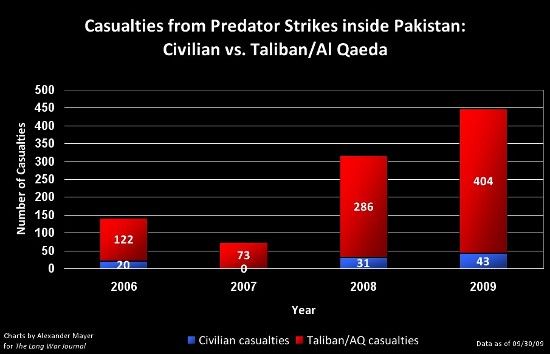Peter Bergen and Katherine Tiedemann have published an analysis for the New America Foundation about US drone strikes in Pakistan. Citing previous analyses of drone strike statistics, including the recent report in The Long War Journal, Bergen and Tiedemann conclude that based on their research, between 31 and 33 percent of all casualties from drone strikes inside Pakistan have been civilians.
Bergen and Tiedemann did a fairly good job with their analysis. They debunked some of the rather outlandish estimates of civilian deaths — including that of Andrew Exum and David Kilcullen, who implausibly claimed in a New York Times op-ed that 98 percent of the casualties from drone strikes have been civilians. Our 10 percent civilian casualty figure was, as we noted, a low-end estimate. A 30 percent civilian casualty rate is certainly plausible.
Obviously, the problem of distinguishing between civilian and militant casualties in this situation is problematic. Essentially, Bergen and Tiedemann’s methodology was the inverse of ours: They counted the number of casualties specifically described in press reports as “militants” and subtracted that number from the total killed to get the number of civilian deaths. On the other hand, we counted the number of casualties specifically described as civilians, and subtracted that from the total to get the number of militants killed.
When taken together, I think our two reports provide a fairly good triangulation on what is most likely the actual number. In fact, I wouldn’t be surprised if the “real” number of civilian deaths was somewhere in the middle (around 18-20 percent).
Are you a dedicated reader of FDD's Long War Journal? Has our research benefitted you or your team over the years? Support our independent reporting and analysis today by considering a one-time or monthly donation. Thanks for reading! You can make a tax-deductible donation here.









6 Comments
Analysis like this isn’t going to convince any fence sitters, when the data is noisy.
What does the army say. They are the ones on ground and they should have a clearer picture of civlian/militant split. I don’t expect them to release their version for obvious reasons.
Bill,
This is implausible on face.
You’re counting journalist counts of civilian to militant ratios in media reports without controlling for source.
The first thing you’re missing is how many of those assessments come from US military press releases. There’s a reason we stopped keeping an overall body count: history demonstrates that we are bad at it. When killing civilians gets you in trouble, all ambiguities will be interpreted as “not civilian”, and any reports not externally double checked will pass those errors onward.
Sure, Afghan civlians sympathetic to the Taliban might also be somewhat biased – but the whole premise of this COIN effort is that by and large the Taliban remain very unpopular. So that effect should be a fraction of the reverse.
When the enemy dresses like civilians and hides in the civilian population, the resulting data will be noisy. The enemy does this on purpose to use “false” claims of civilian deaths to rally their supporters. They even take up firing positions in homes with the homeowners families right there.
Lets subtract all males of military age and all former mujihadeen from that civilian number. And how about all women working as logistical support troops (cooks, medics) and all children suicide bombers.
I think it’s a strawman to even have a discusion about it. How many in the World Trade Center were civilians? Who cares? Our enemy certainly does not. Did it matter to the inhabitants of Dresden or Warsaw, Stalingrad, Nagasaki, Hiroshima, or Mumbai?
Perhaps if they were civilians suporting the US, I might see it differently, but they are not. In fact, can I subtract supporters of the Taliban and Al Qaeda also? That leaves me with a pretty low number. In fact so low, that the US should be praised for how well they limit civilian deaths. I don’t think that was the premise or the resulting conclusion of their article.
And I doubt that these strikes are not ALL authorized by the Pakistanis, even though they like to pretend they are not. Lies and deception. All part of the enemies plans. Lets not help them. Expose the truth.
glasnost,
Your entire comment is implausible. This has nothing to do with Afghanistan. The press reports are from the Pakistani media. The US military doesn’t even admit to carrying out the strikes in Pakistan, let alone issue press releases. My suggestion is to re-read Alex’s post, then follow through the links and read our original report on the US airstrikes in Pakistan.
Wait, what exactly is the LWJ’s graph saying? The Bergen/Tiedemann report says anywhere from 250 to 320 civilians were killed in strikes, whereas the graph makes it look as though only 94 civilians were killed.
Peter,
We did our own study, and found that 94 civilians were killed (we believe this number is low, and stated this in our report, but given the methodology we chose the number is the number). The graph you see is from our numbers.
The Bergen/Tiedemann report said between 250 to 320 civilians were killed.
I hope that is clear. If not please restate your question.